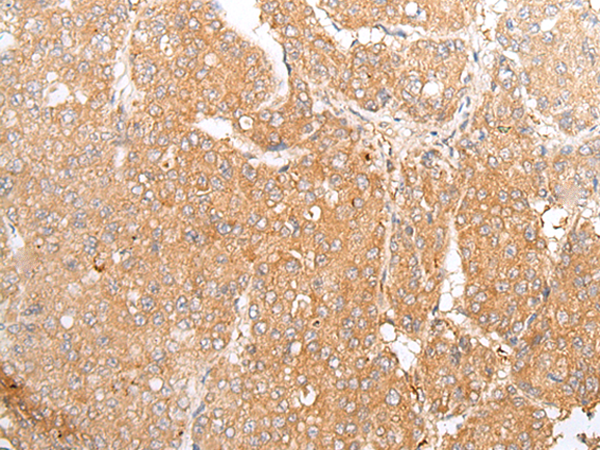
| WB | 咨询技术 | Human,Mouse,Rat |
| IF | 咨询技术 | Human,Mouse,Rat |
| IHC | 1/25-1/100 | Human,Mouse,Rat |
| ICC | 技术咨询 | Human,Mouse,Rat |
| FCM | 咨询技术 | Human,Mouse,Rat |
| Elisa | 1/5000-1/10000 | Human,Mouse,Rat |
| Aliases | GRVS638; PRO1268 |
| Host/Isotype | Rabbit IgG |
| Antibody Type | Primary antibody |
| Storage | Store at 4°C short term. Aliquot and store at -20°C long term. Avoid freeze/thaw cycles. |
| Species Reactivity | Human |
| Immunogen | Synthetic peptide of human TMEM107 |
| Formulation | Purified antibody in PBS with 0.05% sodium azide and 50% glycerol. |
+ +
以下是关于TMEM107抗体的3篇参考文献,简要总结如下:
---
1. **文献名称**: *TMEM107 regulates ciliary localization of hedgehog signaling components in mammalian development*
**作者**: Li Y, et al.
**摘要**: 研究利用TMEM107抗体进行免疫荧光实验,发现TMEM107蛋白在小鼠胚胎纤毛中定位,并调控Hedgehog信号通路关键蛋白的运输,提示其与纤毛功能障碍相关疾病的潜在关联。
---
2. **文献名称**: *Mutations in TMEM107 cause Joubert syndrome by impairing ciliary transition zone assembly*
**作者**: Shaheen R, et al.
**摘要**: 通过Western blot和免疫组化(使用TMEM107抗体),作者发现TMEM107基因突变导致纤毛过渡带结构异常,进而引发Joubert综合征,揭示了该蛋白在神经发育中的作用。
---
3. **文献名称**: *TMEM107 is a critical regulator of cerebellar granule neuron development*
**作者**: Huang L, et al.
**摘要**: 研究利用TMEM107抗体敲除模型,证明该蛋白通过调控Sonic Hedgehog通路影响小脑颗粒神经元的分化,为相关发育障碍提供了分子机制解释。
---
如需更多文献,建议在PubMed或Google Scholar中以“TMEM107 antibody”或“TMEM107 function”为关键词进一步检索。
The TMEM107 antibody is a research tool designed to target the transmembrane protein 107 (TMEM107), a conserved ciliary protein implicated in cilia formation, signaling, and disease. TMEM107 localizes to the transition zone of primary cilia, where it plays a critical role in regulating ciliary composition and Sonic Hedgehog (Shh) signaling. Mutations in the TMEM107 gene are associated with ciliopathies, such as Joubert syndrome, Meckel-Gruber syndrome, and skeletal dysplasia, underscoring its importance in developmental processes.
Antibodies against TMEM107 are typically developed in rabbits or mice using synthetic peptides or recombinant protein fragments as immunogens. These antibodies are validated for applications like Western blotting, immunofluorescence, and immunohistochemistry to study TMEM107 expression, subcellular localization, and interactions with ciliary complexes (e.g., CPLANE proteins). Researchers also use TMEM107 antibodies to investigate disease mechanisms in ciliopathy models or to assess tissue-specific protein dysregulation.
Recent studies highlight TMEM107's role in ciliary gatekeeping and its functional interplay with other ciliopathy-associated proteins (e.g., TMEM231. TMEM67). As cilia research expands, TMEM107 antibodies remain vital for dissecting ciliary biology and exploring therapeutic targets for ciliopathies. Commercial sources often provide species reactivity (human, mouse, rat) and specificity data via knockout validation to ensure reliability.
×